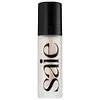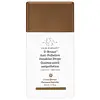Saie Glowy Super Gel Lightweight Dewy Highlighter Versus Drunk Elephant D-Bronzi Anti-Pollution Sunshine Drops
What's inside
What's inside
 Key Ingredients
Key Ingredients

 Benefits
Benefits

 Concerns
Concerns

 Ingredients Side-by-side
Ingredients Side-by-side

Water
Skin ConditioningCaprylic/Capric Triglyceride
MaskingPropanediol
SolventGlycerin
HumectantMica
Cosmetic ColorantHydroxyethyl Acrylate/Sodium Acryloyldimethyl Taurate Copolymer
Emulsion StabilisingSqualane
EmollientCaprylyl Glycol
EmollientPhenethyl Alcohol
MaskingEthylhexylglycerin
Skin ConditioningPolysorbate 60
EmulsifyingAscorbyl Tetraisopalmitate
AntioxidantCarica Papaya Seed Oil
HumectantRosa Canina Fruit Oil
EmollientLactic Acid
BufferingCI 77891
Cosmetic ColorantCI 77491
Cosmetic ColorantWater, Caprylic/Capric Triglyceride, Propanediol, Glycerin, Mica, Hydroxyethyl Acrylate/Sodium Acryloyldimethyl Taurate Copolymer, Squalane, Caprylyl Glycol, Phenethyl Alcohol, Ethylhexylglycerin, Polysorbate 60, Ascorbyl Tetraisopalmitate, Carica Papaya Seed Oil, Rosa Canina Fruit Oil, Lactic Acid, CI 77891, CI 77491
Water
Skin ConditioningHydrogenated Polyisobutene
EmollientGlyceryl Oleate Citrate
EmulsifyingMica
Cosmetic ColorantHydroxyethyl Acrylate/Sodium Acryloyldimethyl Taurate Copolymer
Emulsion StabilisingGlycerin
HumectantRibes Nigrum Seed Oil
EmollientSclerocarya Birrea Seed Oil
HumectantTheobroma Cacao Extract
Skin ConditioningCaprylic/Capric Triglyceride
MaskingVitis Vinifera Seed Extract
AntimicrobialLecithin
EmollientAcetyl Tetrapeptide-17
Skin ConditioningLinoleic Acid
CleansingLinolenic Acid
CleansingSorbitan Isostearate
EmulsifyingCamellia Sinensis Leaf Extract
AntimicrobialMaltodextrin
AbsorbentSodium Hyaluronate Crosspolymer
HumectantMagnolia Officinalis Bark Extract
AntimicrobialGlutamylamidoethyl Imidazole
Colloidal Platinum
AntimicrobialTocopherol
AntioxidantPhenoxyethanol
PreservativePentylene Glycol
Skin ConditioningSodium Benzoate
MaskingSorbic Acid
PreservativeCaprylyl Glycol
EmollientBoron Nitride
AbsorbentHexylene Glycol
EmulsifyingPolysorbate 60
EmulsifyingEthylhexylglycerin
Skin ConditioningCI 77491
Cosmetic ColorantCI 77492
Cosmetic ColorantCI 77499
Cosmetic ColorantSodium C14-16 Olefin Sulfonate
CleansingWater, Hydrogenated Polyisobutene, Glyceryl Oleate Citrate, Mica, Hydroxyethyl Acrylate/Sodium Acryloyldimethyl Taurate Copolymer, Glycerin, Ribes Nigrum Seed Oil, Sclerocarya Birrea Seed Oil, Theobroma Cacao Extract, Caprylic/Capric Triglyceride, Vitis Vinifera Seed Extract, Lecithin, Acetyl Tetrapeptide-17, Linoleic Acid, Linolenic Acid, Sorbitan Isostearate, Camellia Sinensis Leaf Extract, Maltodextrin, Sodium Hyaluronate Crosspolymer, Magnolia Officinalis Bark Extract, Glutamylamidoethyl Imidazole, Colloidal Platinum, Tocopherol, Phenoxyethanol, Pentylene Glycol, Sodium Benzoate, Sorbic Acid, Caprylyl Glycol, Boron Nitride, Hexylene Glycol, Polysorbate 60, Ethylhexylglycerin, CI 77491, CI 77492, CI 77499, Sodium C14-16 Olefin Sulfonate
 Reviews
Reviews

Ingredients Explained
These ingredients are found in both products.
Ingredients higher up in an ingredient list are typically present in a larger amount.
This ingredient is an emollient, solvent, and texture enhancer. It is considered a skin-softener by helping the skin prevent moisture loss.
It helps thicken a product's formula and makes it easier to spread by dissolving clumping compounds.
Caprylic Triglyceride is made by combining glycerin with coconut oil, forming a clear liquid.
While there is an assumption Caprylic Triglyceride can clog pores due to it being derived from coconut oil, there is no research supporting this.
Learn more about Caprylic/Capric TriglycerideCaprylyl Glycol is a humectant and emollient, meaning it attracts and preserves moisture.
It is a common ingredient in many products, especially those designed to hydrate skin. The primary benefits are retaining moisture, skin softening, and promoting a healthy skin barrier.
Though Caprylyl Glycol is an alcohol derived from fatty acids, it is not the kind that can dry out skin.
This ingredient is also used as a preservative to extend the life of products. It has slight antimicrobial properties.
Learn more about Caprylyl GlycolCi 77491 is also hydrated iron III oxide. It's sole purpose is to give a red/pink hue to products.
Iron III oxides are classified as inorganic chemicals for coloring.
Synthetically created Ci 77491 is considered safer than those naturally found. This is because the synthetically created version may contain less impurities. Iron oxides are generally non-toxic and non-allergenic.
Learn more about CI 77491Ethylhexylglycerin (we can't pronounce this either) is commonly used as a preservative and skin softener. It is derived from glyceryl.
You might see Ethylhexylglycerin often paired with other preservatives such as phenoxyethanol. Ethylhexylglycerin has been found to increase the effectiveness of these other preservatives.
Glycerin is already naturally found in your skin. It helps moisturize and protect your skin.
A study from 2016 found glycerin to be more effective as a humectant than AHAs and hyaluronic acid.
As a humectant, it helps the skin stay hydrated by pulling moisture to your skin. The low molecular weight of glycerin allows it to pull moisture into the deeper layers of your skin.
Hydrated skin improves your skin barrier; Your skin barrier helps protect against irritants and bacteria.
Glycerin has also been found to have antimicrobial and antiviral properties. Due to these properties, glycerin is often used in wound and burn treatments.
In cosmetics, glycerin is usually derived from plants such as soybean or palm. However, it can also be sourced from animals, such as tallow or animal fat.
This ingredient is organic, colorless, odorless, and non-toxic.
Glycerin is the name for this ingredient in American English. British English uses Glycerol/Glycerine.
Learn more about GlycerinThis is a synthetic polymer. It helps improve the texture of products by adding thickness and gel-like feel.
It is also an emulsifer, meaning it prevents ingredients such as oil and water from separating. It also helps evenly disperse other ingredients.
Mica is a naturally occurring mineral used to add shimmer and color in cosmetics. It can also help improve the texture of a product or give it an opaque, white/silver color.
Serecite is the name for very fine but ragged grains of mica.
This ingredient is often coated with metal oxides like titanium dioxide. Trace amounts of heavy metals may be found in mica, but these metals are not harmful in our personal products.
Mica has been used since prehistoric times throughout the world. Ancient Egyptian, Indian, Greek, Roman, Aztec, and Chinese civilizations have used mica.
Learn more about MicaPolysorbate 60 is used to help stabilize products. It is a surfactant and emulsifier. These properties help keep ingredients together in a product. Surfactants help reduce surface tension between ingredients with different states, such as liquids and solids. Emulsifiers help prevent oils and waters from separating.
Polysorbate 60 is sorbitol-based and created from the ethoxylation of sorbitan. Ethoxylation is a chemical reaction used to add ethylene oxide. Sorbitan is a the dehydrated version of sorbitol, a sugar found in fruits.
In this case, the 60 comes from reacting 60 units of ethylene oxide with sorbitan.
Polysorbates are commonly used in medicine and foods.
Learn more about Polysorbate 60Water. It's the most common cosmetic ingredient of all. You'll usually see it at the top of ingredient lists, meaning that it makes up the largest part of the product.
So why is it so popular? Water most often acts as a solvent - this means that it helps dissolve other ingredients into the formulation.
You'll also recognize water as that liquid we all need to stay alive. If you see this, drink a glass of water. Stay hydrated!
Learn more about Water